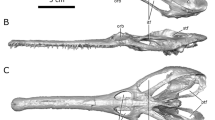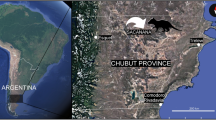Abstract
The distribution of air-filled structures in the craniofacial and neurocranial bones of the oviraptorid ZPAL MgD-I/95, discovered at the Hermiin Tsav locality, Mongolia, is restored. Based on the complete obliteration of most of the cranial sutures, the specimen is identified as an adult individual of Conchoraptor gracilis Barsbold 1986. Except for the orbitosphenoids and epipterygoids, the preserved bones of the neurocranium are hollow. Three types of tympanic recess are present in Conchoraptor, a characteristic shared with troodontids, dromaeosaurids, and avian theropods. The contralateral middle ear cavities are interconnected by the supraencephalic pathway that passes through the dorsal tympanic recesses, the posterodorsal prootic sinuses and the parietal sinus. The spatial arrangements of the middle ear cavity and a derived neurocranial pneumatic system in Conchoraptor indicate enhancements of acoustic perception in the lower-frequency registers and of auditory directionality. We further speculate that this improvement of binaural hearing could be explained as an adaptation required for accurate detection of prey and/or predators under conditions of low illumination. The other potentially pneumatic structures of the Conchoraptor cranium include (1) recessus-like irregularities on the dorsal surface of the nasal and frontal bones (a putative oviraptorid synapomorphy; pos); (2) a subotic recess; (3) a sub-condylar recess; and (4) a posterior condylar recess (pos).




Similar content being viewed by others
References
Barsbold R (1974) Saurornithoididae, a new family of small theropod dinosaurs from Central Asia and North America. Palaeontol Pol 30:5–22
Barsbold R (1986) Raubdinosaurier Oviraptoren. In: Vorobyeva EI (ed) Gerpetologičeskie issledovaniâ v Mongol’skoi Narodnoj Respublike, Institut Evolyucionnoy Morfologii i Ekologii Zhivotnikh im. A. N. Severcova, Akademia Nauk SSSR, Moscow, pp 210–223
Barsbold R, Osmólska H (1999) The skull of Velociraptor (Theropoda) from the Late Cretaceous of Mongolia. Acta Palaeontol Pol 44:189–219
Clark JM, Norell MA, Rowe T (2002) Cranial anatomy of Citipati osmolskae (Theropoda, Oviraptorosauria), and a reinterpretation of the holotype of Oviraptor philoceratops. Am Mus Novit 3364:1–24
Currie PJ (1995) New information on the anatomy and relationships of Dromaeosaurus albertensis (Dinosauria: Theropoda). J Vertebr Paleontol 15:576–591
Currie PJ, Zhao X-J (1993) A new troodontid (Dinosauria, Theropoda) braincase from the Dinosaur Park Formation (Campanian) of Alberta. Can J Earth Sci 30:2231–2247
Dooling RJ, Ryals BM (1997) Auditory perception and plasticity in the avian auditory system. J Acoust Soc Am 101:3191
Freye-Zumpfe H (1953) Befunde im Mittelohr der Vögel. Wiss Z Martin-Luther-Univ Halle-Witten 2:445–461
Henson OW (1974) Comparative anatomy of the middle ear. In: Keidel WD, Neff WD (eds) Handbook of sensory physiology, vol V. Springer, Berlin Heidelberg New York, pp 39–110
Hill KG, Lewis DB, Hutchings ME, Coles RB (1980) Directional hearing in the Japanese Quail (Coturnix japonica). I. Acoustic properties of the auditory system. J Exp Biol 86:135–151
Ji Q, Currie PJ, Norell MA, Ji S-A (1998). Two feathered dinosaurs from northeastern China. Nature 393:753–761
Kühne R, Lewis B (1985) External and middle ears. In: King AS, McLelland J (eds) Form and function in birds, vol 3. Academic, New York, pp 227–271
Kundrát M (2007) Avian-like attributes of a virtual brain model of the oviraptorid theropod Conhoraptor gracilis. Naturwissenschaften 94:499–504
Larsen ON, Dooling RJ, Michelsen A (2006) The role of pressure difference reception in the directional hearing of budgerigars (Melopsittacus undulatus). J Comp Physiol A 192(10):1063–1072
Larsen ON, Dooling RJ, Ryals BM (1996) Roles of intracranial air pressure in bird audition. In: Lewis ER, Miller GR (eds) Diversity in auditory mechanics. World Scientific, Singapore, pp 11–17
Lewis DB (1983) Directional cues for auditory localisation. In: Lewis DB (ed) Bioacoustics. Academic, London, pp 233–257
Makovicky PJ, Norell MA (1998) A partial ornithomimid braincase from Ukhaa Tolgod (Upper Cretaceous, Mongolia). Am Mus Novit 3247:1–16
Makovicky PJ, Norell MA, Clark JM, Rowe T (2003) Osteology and relationships of Byronosaurus jaffei (Theropoda: Troodontidae). Am Mus Novit 3402:1–32
Norberg RÅ (1978) Skull asymmetry, ear structure and function, and auditory localization in Tengmalm’s owl, Aegolius funereus (Linné). Philos Trans R Soc Lond B 282:325–410
Norell MA, Clark JM, Turner AH, Makovicky PJ, Barsbold R, Rowe T (2006) A new dromaeosaurid theropod from Ukhaa Tolgod (Ömnögov, Mongolia). Am Mus Novit 3545:1–51
Norell MA, Makovicky PJ, Clark JM (2004) The braincase of Velociraptor. In: Currie PJ, Koppelhaus EB, Shugar MA, Wright JL (eds) Feathered dragons: studies on the transition from dinosaurs to birds (life of the past). Indiana University Press, Bloomington, pp 133–143
Osmólska H (1976) New light on the skull anatomy and systematic position of Oviraptor philoceratops. Nature 262:683–684
Payne RS (1971) Acoustic location of prey by barn owls (Tyto alba). J Exp Biol 54:535–573
Rauhut OW (2004) Braincase structure of the Middle Jurassic theropod dinosaur Piatnitzkysaurus. Can J Earth Sci 41:1109–1122
Saiff EI (1988) The anatomy of the middle ear of the tinamiformes. J Morphol 196:107–116
Saunders JC, Johnstone BM (1972) A comparative analysis of middle ear function in non-mammalian vertebrates. Acta Oto Laryngol 73:353–361
Schwartzkopff J (1952) Untersuchungen über die Arbeitsweise des Mittelohres und das Richtunshören der Singvögel unter Verwendung von Cochlea-Potentialen. Z Vgl Physiol 32:319–327
Smith DK (1993) The type specimen of Oviraptor philoceratops, a theropod dinosaur from the Upper Cretaceous of Mongolia. Neues Jharb Geol Paläontol Abh 186:365–388
Starck JM (1995) Comparative anatomy of the external and the middle ear of palaeognathous birds. In: Beck F, Galveston WH, Kriz W, Pauly JE, Sano Y, Schlieber TH (eds) Advances in anatomy embryology and cell biology, vol 131. Springer, Berlin Heidelberg New York, pp 1–137
Stellbogen E (1930) Über das äussere und mittlere Ohr des Waldkauzes (Syrnium aluco, L.). Z Morphol Ökol Tiere 19:686–731
Wada Y (1924) Beiträge zur vergleichenden Physiologie des Gehörorgans. Pflügers Arch Gesamte Physiol Menschen Tiere 202:46–49
Walker AD (1985) The braincase of Archaeopteryx. In: Hecht MK, Ostrom JH, Viohl G, Wellnhofer P (eds) The beginnings of birds. Freunde des Jura-Museums, Eichstätt, pp 123–134
Witmer LM (1990) The craniofacial air sac system of Mesozoic birds (Aves). Zool J Linn Soc 100:327–378
Witmer LM (1997) Craniofacial air sinus system. In: Currie PJ, Padian K (eds) Encyclopedia of dinosaurs. Academic, San Diego, pp 151–159
Xu X, Norell MA, Wang X-L, Makovicky P, Wu X-C (2002) A basal troodontid from the Early Cretaceous of China. Nature 415:780–784
Acknowledgements
The authors thank Ole N. Larsen, Gareth Dyke, and Kevin Padian for reading and commenting on an earlier version of this manuscript, Gerald Mayr for his valuable editing and editorial comments, and Randy and Deb Lyons for their rigorous edit of the final version of the manuscript. Our special thanks to Halszka Osmólska and Teresa Maryańska for providing access to the fossil specimen and Zdeněk Seidl and Vladimír Smékal for providing access to the CT facility.
Author information
Authors and Affiliations
Corresponding author
Electronic supplementary material
Below is the image is a link to a high resolution version
Supplementary Fig. S1
Transversal CT-scan sections through the rostral part of the skull of Conchoraptor gracilis, ZPAL MgD-I/95 (JPG 662 kb)
Supplementary Fig. S2
Transversal CT-scan sections through the anterior neurocranium of Conchoraptor gracilis, ZPAL MgD-I/95 (a)(JPG 436 kb) (b)(JPG 327 kb)
Supplementary Fig. S3
Transveral CT-scan sections through the posterior neurocranium of Conchoraptor gracilis, ZPAL MgD-I/95 (a)(JPG 578 kb) (b)(JPG 330 kb)
Rights and permissions
About this article
Cite this article
Kundrát, M., Janáček, J. Cranial pneumatization and auditory perceptions of the oviraptorid dinosaur Conchoraptor gracilis (Theropoda, Maniraptora) from the Late Cretaceous of Mongolia. Naturwissenschaften 94, 769–778 (2007). https://doi.org/10.1007/s00114-007-0258-7
Received:
Revised:
Accepted:
Published:
Issue Date:
DOI: https://doi.org/10.1007/s00114-007-0258-7




